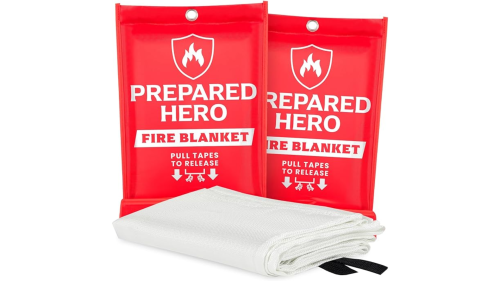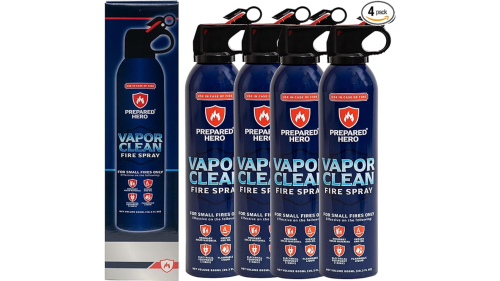By Rikki Roehrich
Cooking causes approximately 158,000 home fires annually, and is considered the number one cause of home fires and home injuries, according to NFPA Research. More specifically, cooking caused 44% of reported home fires, 18% of reported home fire deaths and 42% of home fire injuries. Many of these incidents are grease fires.
Knowing how to respond quickly and put out a grease fire could be the difference between a minor kitchen fire and a devastating disaster. In an effort to keep your home and community safe, please share these tips with friends and family so they are equipped to put out a grease fire.
How to put out a grease fire
Follow these four steps to extinguish a grease fire:
- Cover the flames with a metal lid or cookie sheet. Leave the cover on until it has cooled.
- Turn off the heat source.
- If it’s a small and manageable fire, pour baking soda or salt on it to smother the fire.
- As a last resort, spray the fire with a Class B dry chemical fire extinguisher.
Additional tips:
- Do NOT try to extinguish the fire with water.
- Do not attempt to move the pot or pan outside.
- Do not use flour, baking powder or other cooking powders that resemble baking soda or salt – they have a different chemical makeup and will not react similarly. They will make the fire worse.
It’s also important to remember that three out of five non-fatal home cooking fire injuries occurred when the victim tried to fight the fire themselves. The most common injuries sustained were burns to the hands and lower arms.
What type of fire extinguisher should I use on a grease fire?
Use a Class B or Class K fire extinguisher to put out a grease fire.
A Class B fire extinguisher is specifically designed to combat fires involving flammable liquids and gases, such as gasoline, oil, paint, and solvents. Carbon dioxide extinguishers take away the oxygen element of the fire triangle. They also remove the heat with a cold discharge.
Class K fires involve vegetable oils, animal oils, or fats in cooking appliances. Class K extinguishers contain a wet chemical agent that, when discharged, reacts with the oils and fats, creating a soapy barrier that prevents reignition and cools the flames. While Class K extinguishers are effective for grease fires, they are not a substitute for other types of extinguishers, like ABC extinguishers, which are designed for other classes of fires.
If you are unable to extinguish the grease fire:
- GET OUT! You and your family members need to leave as soon as you can to prevent injury or loss of life. Do not try to be a hero.
- Close the door as you leave to help contain the fire.
- Call 911 as soon as you are at a safe distance from the fire.
- Do not re-enter your home until the fire has been contained by firefighters.
While it is important to remember these steps in order to take appropriate action during a grease fire, it’s equally important to take actions to prevent them from occurring in the first place.
How to prevent grease fires
- The leading cause of fires in the kitchen is unattended cooking. Stay in the kitchen while you are frying, grilling, boiling or broiling food.
- Be alert and do not use the stove or stovetop if you are sleepy or have consumed alcohol.
- Keep anything that can catch fire away from your stovetop.
- Remove as much moisture as possible from the food before putting it in hot oil. Do not put frozen foods into hot grease.
- Keep the grease at the recommended temperature. If you see any smoke or the oil smells, it is an indication that it is too hot. Immediately turn off the burner to let it cool down.
- Heat the oil slowly.
- Add food gently to prevent splatter.
- Keep a lid near the pan you’re cooking with so that it is accessible if a fire starts.
- Always keep children away from the stove while cooking.
In addition to these tips, it is also a good practice to be mindful of times grease fires are more likely to occur. Thanksgiving is the peak day for home cooking fires, followed by the day before Thanksgiving and then Christmas and Christmas Eve. On a regular day, the most common time to experience a grease fire is between 5-8 p.m.
This is what happens when you try to put out a grease fire with water. Instead, cover the pan with a lid and turn off the burner! Come check out the kitchen fire demo all day today at the @mnstatefair. pic.twitter.com/5KrvOv6diU
— State Fire Marshal (@MnDPS_SFM) August 26, 2022
By using proper cooking techniques and best practices, frying with grease or oil should pose a relatively small risk. Still, it’s always good to keep this information nearby in the event you do experience a grease fire. A quick and proper reaction will minimize any damage as well as prevent injury and death.
Next, read about how to put out an electrical fire in five steps.
Author’s note: A generous thank you to Captain Jeremy Francis and Firefighter Steven Malzachar from the Bismarck (North Dakota) Fire Department and Fire Chief Steve Nardello from the Mandan (North Dakota) Fire Department for their contributions to this article.
ABOUT THE AUTHOR
Rikki Roehrich is a writer and program manager. She has a master’s of the arts communication and media studies and a bachelor’s degree in mass communications and media studies from California State University-Sacramento. Connect with Roehrick on LinkedIn.
This article, originally published on March 21, 2017, has been updated to include more recent statistics and new information.
















